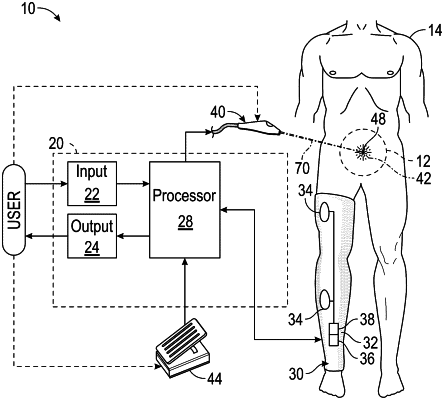| CPC A61B 5/395 (2021.01) [A61B 5/1107 (2013.01); A61B 5/7221 (2013.01); A61B 5/726 (2013.01)] | 8 Claims |

|
1. An intraoperative neural monitoring system for use during a surgical procedure on a subject, the system comprising:
a selectively electrifiable nerve stimulator for applying an electrical stimulus to a nerve or nerve root of the subject during a surgical procedure, the nerve stimulator including:
an elongate body with a handle and/or handle connector at a proximal end portion and a stimulator tip at a distal end portion, the handle connector and stimulator tip being electrically conductive and in electrical communication with each other, and an exterior surface of the body between the handle connector and the stimulator tip being non-conductive, the stimulator tip including an exposed electrode operative to apply the electrical stimulus; and
wherein the applied electrical stimulus comprises a plurality of discrete electrical pulses, each pulse spaced in time from a previously administered electrical pulse by a stimulation period;
a mechanical sensor configured to:
monitor a physical motion of a muscle of the subject; and
provide a mechanomyography (MMG) signal corresponding to the monitored physical motion; and
a processor configured to:
receive the MMG signal;
for each wavelet of a plurality of wavelets, compute a convolution coefficient that is representative of a degree of similarity between the MMG signal and the wavelet;
consolidate the computed convolution coefficient from each wavelet into a single net-convolution coefficient at each of a plurality of sequential timesteps;
identify a plurality of peaks within the net-convolution coefficient, each peak being spaced in time from a previously identified peak by a time period;
determine that the physical motion of the muscle is an artificially induced neuromuscular response attributable to the applied electrical stimulus if the time period between identified peaks in the net-convolution coefficient matches the stimulation period between administered electrical pulses; and
provide an indication to a user if it is determined that the monitored physical motion of the muscle is an artificially induced neuromuscular response.
|